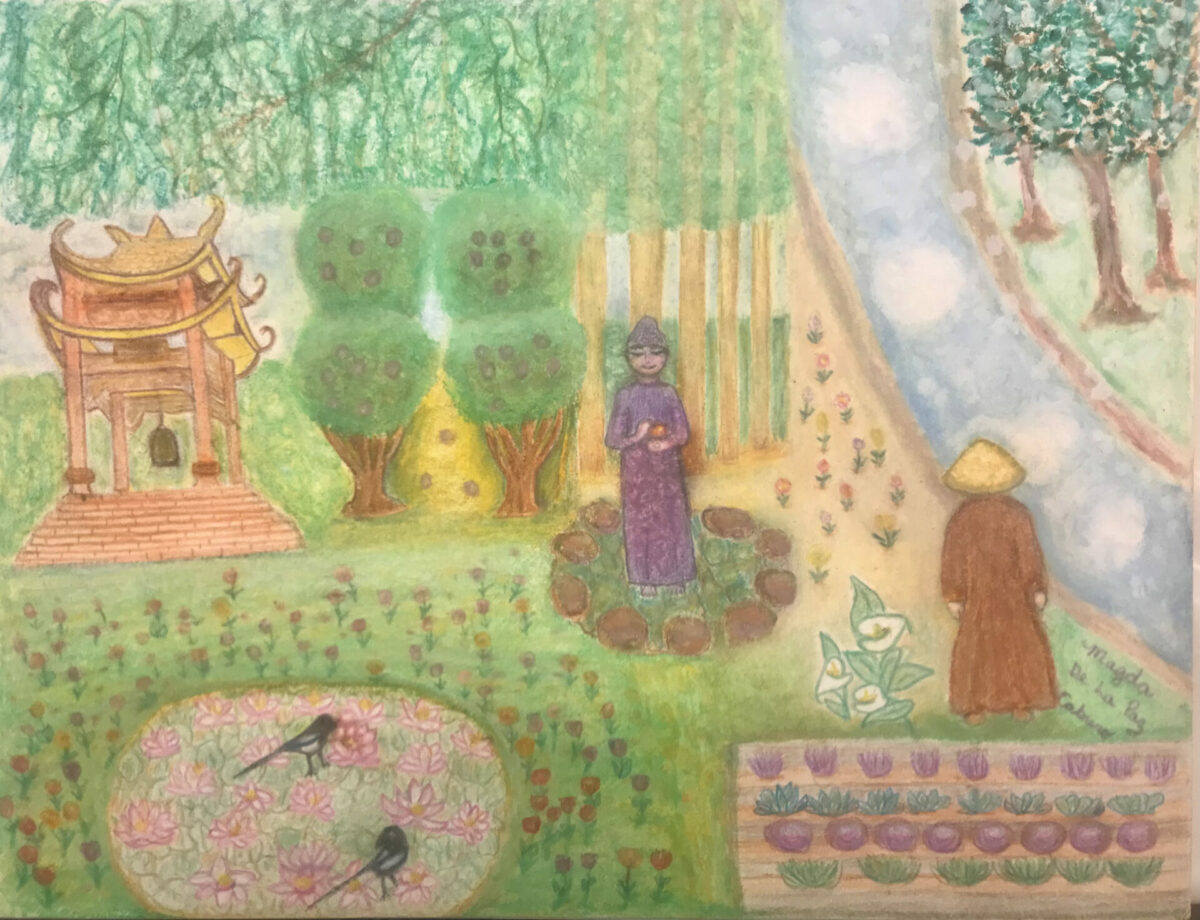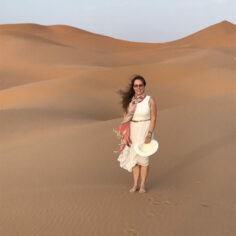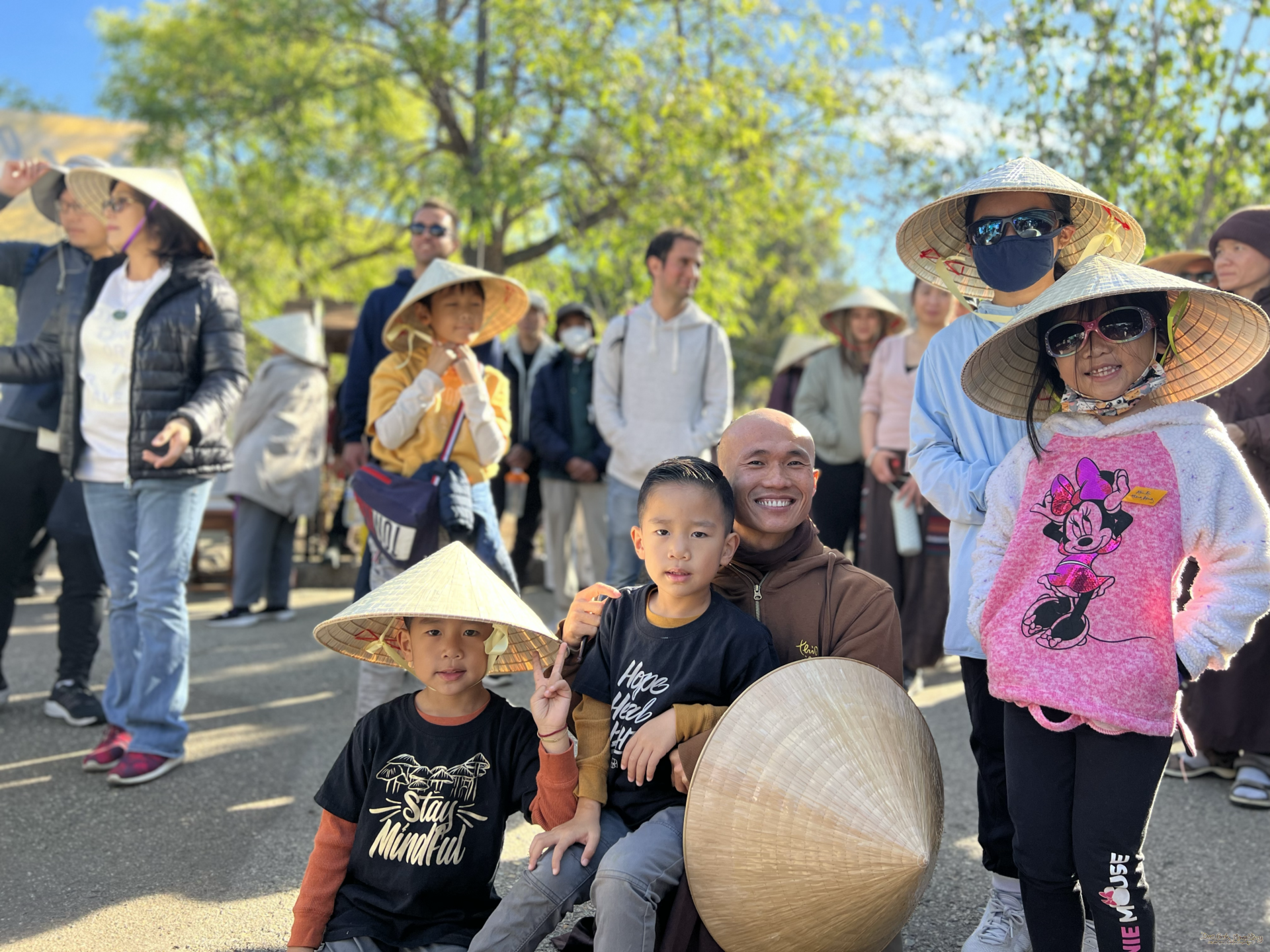By Dr. Magda De La Paz Cabrero on
Dr. Magda De La Paz Cabrero takes us on a tour through nature’s beauty in Plum Village, France and shares how her experience deepened her relationship with Mother Earth.
Bodhisattva
When I arrived in Plum Village, spring was in full, exuberant bloom: tall grasses washed in wild flower pigments,
By Dr. Magda De La Paz Cabrero on
Dr. Magda De La Paz Cabrero takes us on a tour through nature’s beauty in Plum Village, France and shares how her experience deepened her relationship with Mother Earth.
Bodhisattva
When I arrived in Plum Village, spring was in full, exuberant bloom: tall grasses washed in wild flower pigments, the farm, banana trees, lilies, roses, and velvet plants, circular bamboo groves, the plum orchard, the poplar forest, and all kinds of flora. Plum Village’s natural surroundings fit Thích Nhất Hạnh’s description of Mother Earth as a bodhisattva. Most residents were engaged in some kind of earth project. The monks and nuns were building a bench with bamboo branches. I know Thầy would have felt fully satisfied with this microcosmos. We all are his continuation, humans and nature.
As I walked through the farm, I said to myself: “In Plum Village the phrase ‘We are what we eat’ truly resonates.” I read a sign: “Happy farmers make the world a better place.” I know many of the abundant vegetables we eat in Plum Village grow here. When we eat in Plum Village, our food and those who make it possible are never taken for granted. One bowl of food contains the cosmos. I would like to return next spring to help the happy farmers and to spend time with my hands in the soil.
As I walked by the plum orchard, I noticed how many people walked barefoot and how this spontaneously caused our feet to relax their pace. I believe most of us are mindful that the terrain underfoot is a living presence. Intuitively, we remember the ancestral, replenishing affinity between our bodies and the Earth, our more-than-gravitational bond.

Under the willow tree
Sitting under the weeping willow tree in front of the lotus pond, I could see the pagoda, Thầy’s house, the eating hall, the back of the library, and the plum orchard by the poplar tree forest. I saw organic matter in the mud under the pond’s surface, the whole cosmos feeding the lotus flowers.
I was mesmerized by the elegant black and white Eurasian magpie bathing in the pond. When it opened its wings, their black became translucent blue and green. I wondered if the bird lived here the whole year or migrated. How many times had it flown to Plum Village? If I were a bird, I would choose Plum Village too.
While I delighted in the magpie, the wind caressed and tickled my skin, brushing against and tangling my hair. My thoughts turned to the air: Earth is also here in the transparent medium that enfolds us.
I heard the wind whispering in my ear and the poplar leaves jostling and swaying as they touched each other. Like the clapping of happy castanets, the leaves were harmonious in their own choral disorder.
I could smell the mossy poplar scent transported by the wind and soon became aware of my own breathing. I breathed in and pondered the fluid exchange between all Plum Village’s emanations and mine. I breathed out and knew the breath of the whole cosmos was present in my breathing. We–Plum Village and I–breathed in unison. Traces of the environment that surrounded me–the spring scents and pollens, particles, spider webs, earth, sky and water elements, the fermenting compost, insect pheromones, and more–was inhaled, metamorphosed and exhaled. Breathing in and out, I am in, with and of the Earth.
Poplar cathedral
In Plum Village I found myself walking through the poplar forest several times a day. I loved looking at the heart-shaped leaves reflecting the sun in all directions, in shades of green, gold, and silver. Most of the trees’ trunks were covered by moss and ivy: beige, brown, black, and green. I thought about the immeasurable abundance of organic life each tree sustains, and about what I can and cannot perceive. Not a single tree appears to be dying.
During walking meditation, the sister asked us to stop and face the trees. I couldn’t resist touching the bark of the nearest tree, bringing my nose close to smell it. Like the boy in A Christmas Story, I wanted to taste it but thought touching and smelling the tree was already odd enough, even by Plum Village standards.
Depending on where I stood, the rows of trees look straight or perpendicular. They played all kinds of protean optical illusion games with me. I imagined myself as a child playing hide-and-seek. Did the trees run to take a different spot every time I was not looking? I could take a winding path through this improvised labyrinth, a path that brought me closer to home.
I pondered the connections among all the poplar trees. My imagination ran free. I wondered if they felt my presence, my energy of enchantment? Were they as drawn to me as I was to them?
Thầy’s creek
“... as a closed book on a shelf continues to whisper to itself its own inexhaustible tale.”
Annie Dillard
Another place I visited several times a day was Thầy’s favorite sitting spot in front of the creek. In the morning, the creek was covered with cotton-like fiber, like clouds in an overcast sky. This fiber came from nearby trees, whose seeds had formed cotton sails to travel far in the spring wind. How clever is that? When I returned in the afternoon I was surprised that the cotton-clouds had shifted toward the lower part of the creek. Like my Puerto Rican sky, overcast on one side and clear on the other.
This creek, whose rich organic depth is another representation of the cosmos, inspired vivid thoughts about Thích Nhất Hạnh’s deep impact on my life. I especially remember his messages of impermanence and continuation. The creek both flows and endures, always reinventing itself. Thầy will always be a part of this creek, all the rich organic matter below and above the surface, and all its surroundings, including me.
Kinship with the Earth
In Plum Village what I never understood became clear. I remembered my pure, simple ways.
In unison with the Earth’s rhythms, these words sprouted while I sat in front of the black Buddha in the depths of the poplar cathedral.
In Plum Village in the spring I regained an ancestral innocence that brought me back to my deepest kinship with the Earth.


